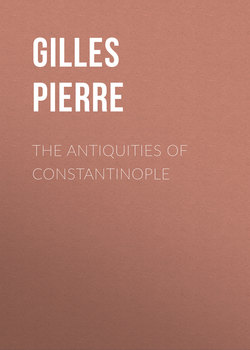Читать книгу The Antiquities of Constantinople - Gilles Pierre - Страница 21
BOOK I
Chap. XVIII.
Of the seventh Hill
ОглавлениеTHE seventh Hill is called the Xerolophos, on which stands the Pillar of Arcadius. This Hill is little less than twelve thousand Paces in Circumference, and contains more than a third Part of the City. The other two Parts are comprehended in the Compass of the Promontory, which is above twenty thousand Paces in Circumference. By Paces, I would here be thought to mean the ordinary Steps we take in Walking, which I cannot exactly reduce to a just Mensuration with the Roman Pace, by reason of the Turnings and Windings of the Ways, and the Differences of Paces, which are longer or shorter, according to the different Ascents and Descents of the Ground we walk. This Hill makes the third Angle of the City, from whence Constantinople is look’d upon to be of a triangular Figure. It lies shelving with a very moderate Descent, and has a double Declivity; one of which falls gently into the Valley, which divides the seventh Hill from the Promontory, and is of an equal Length with the Valley itself. The other Descent, which partly lies to the South-east, and partly to the South, falls into the Propontis, and is in some Places five hundred Paces steep, in others four hundred, three hundred, a hundred, nay even fifty, till it comes to the Point of the third Angle of the City, whence a large Plain shoots out towards the Sea, which, in different Places, is of a different Breadth. The Entrance of this Plain, at the Angle of the City just mention’d, is very narrow; it afterwards widens, which is occasioned by the Winding of one of its Sides, from whence it gently rises to the Foot of a small Hill, where ’tis four hundred Paces broad; onwards it is straiten’d into fifty, and afterwards is widen’d into a Breadth of a hundred Paces only. The End of this Plain, to the Distance of a thousand Paces, is more than four hundred Paces broad. On the Ridge of this Hill, there is a Plain of some Length and Breadth; the Hill itself is bounded by the Land Wall, and on the Top of it is a Cistern which is call’d Mocisia, which is wholly unroof’d, and stripp’d of its Pillars. This Cistern is nine hundred and seventy Paces in Circumference. The Walls of it, which are made of squared Free-stone, are still remaining; and the Ground where it stands, is now turn’d into a Garden.
Thus is it that I have laid before the Reader a Plan or Description of the Situation of the City of Constantinople, by which means the Situation of the Wards of that City will be more easily discovered. I hope I shall not be thought to have dwelt too long on this Subject, since a verbal Delineation of it is the most concise way of coming to the Knowledge of it. For although Constantinople, by reason of the Eminency of its Situation, affords a most agreeable Prospect at the remotest Distance, yet thus to particularize the several Parts of the City, leads the Reader into a more exact and more expeditious Insight into it, than any other Method of Information whatsoever.
